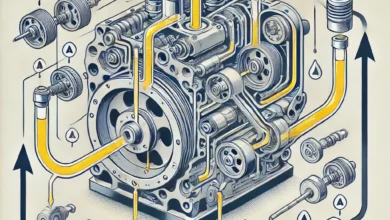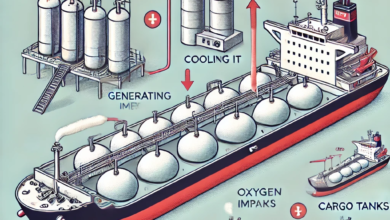Explosive meter Working – made easy | Onboard tanker
Introduction to Explosive Meters
Explosive meters are vital safety devices used onboard tankers to detect the presence of flammable gases in enclosed spaces or storage tanks. These meters continuously sample the air, using sophisticated sensor technologies to detect gas concentrations and prevent potential explosions. By providing real-time monitoring and immediate alerts, explosive meters are indispensable for maintaining safe working conditions in hazardous environments such as oil and chemical tankers.
Why Explosive Meters Are Essential for Tanker Safety
Explosive meters play a critical role in safeguarding tankers against fire and explosion hazards. Tankers often carry volatile and combustible materials, making it essential to monitor the atmosphere within storage tanks and other confined spaces. The primary purpose of these meters is to detect any dangerous accumulation of flammable gases before they reach explosive levels, thereby enabling the crew to take preventive measures, such as increasing ventilation or evacuating personnel.
How Explosive Meters Work
Air Sampling Mechanism
Explosive meters operate by continuously drawing air samples from various locations within the tanker. The air is sampled from storage tanks, confined spaces, and other critical areas where flammable gases could accumulate. This ensures that even the smallest traces of gases are detected early, enabling timely action.
Sensor Technology
The core functionality of an explosive meter lies in its sensor technology, which converts the presence of gases into readable data. There are typically two main types of sensors used in these meters:
- Catalytic Sensors: Catalytic sensors are designed to oxidize the flammable gas on a catalytic element. The process generates heat, leading to a change in resistance, which is measured as a concentration level.
- Infrared Sensors: These sensors detect gas by measuring the absorption of infrared light at specific wavelengths. Different gases absorb different wavelengths, enabling precise identification and measurement of gas concentration.
Signal Processing
Once the sensors detect the presence of gas, the explosive meter processes the raw data and converts it into understandable information. This signal processing step is crucial as it ensures that the meter provides accurate readings of gas concentrations, which can then be compared against safe operating thresholds.
Alert Systems
If the gas concentration exceeds safe limits, the explosive meter triggers an alert system. This system may include visual indicators like flashing lights and audible alarms, which immediately warn the crew. Upon receiving an alert, appropriate actions, such as ventilating the area or evacuating personnel, must be taken to mitigate risks.
Continuous Monitoring and Readouts
Explosive meters provide both digital and analog readouts, displaying real-time concentrations of gases. This feature enables continuous monitoring, which is essential for the dynamic and changing environments onboard tankers. Continuous monitoring also ensures that crew members are aware of atmospheric conditions at all times.
Types of Sensors Used in Explosive Meters
Catalytic Sensors
Catalytic sensors function by oxidizing the flammable gas on a catalytic surface. The heat generated by this reaction changes the resistance of the catalytic element, which is measured and translated into a concentration reading. These sensors are highly effective for detecting a wide range of combustible gases, but they require regular calibration to maintain accuracy.
Infrared Sensors
Infrared sensors operate by emitting infrared light through the sampled air. Specific gases absorb light at distinct wavelengths, and the sensor measures this absorption to determine gas concentration. Infrared sensors are particularly useful for detecting gases that do not oxidize easily, providing an alternative to catalytic sensors.
Key Features of Explosive Meters
Explosive meters are equipped with several key features that enhance their usability and reliability:
- Multi-Gas Detection: Capable of detecting multiple types of gases simultaneously.
- High Sensitivity: Able to detect low concentrations of flammable gases.
- Durability: Resistant to harsh marine environments and corrosion.
- User-Friendly Interface: Displays clear readouts and is easy to operate.
Best Practices for Using Explosive Meters on Tankers
Regular Calibration and Maintenance
Explosive meters require regular calibration and maintenance to ensure accurate readings. Calibration checks should be performed at regular intervals as recommended by the manufacturer, and the sensors should be tested before each use.
Understanding Readouts and Alarms
The crew must be well-trained in interpreting the readouts and understanding the alarms generated by explosive meters. They should be familiar with the safety thresholds and the necessary actions to take if those thresholds are exceeded.
Common Challenges and Troubleshooting
Explosive meters can sometimes experience sensor drift or interference from other gases, leading to inaccurate readings. Regular sensor calibration, maintenance, and thorough knowledge of the operating environment are key to overcoming these challenges.
Regulatory Standards and Compliance
International Maritime Organization (IMO) Guidelines
The IMO provides guidelines on the use of gas detection equipment onboard tankers, emphasizing the importance of using certified devices that meet specific safety standards.
SOLAS (Safety of Life at Sea) Requirements
Under SOLAS regulations, tankers are required to carry and use explosive meters for safety monitoring. Compliance with these regulations ensures that the tanker operates within safe atmospheric conditions.
Training and Safety Protocols
Training the crew in the proper use of explosive meters is crucial. This includes understanding how to operate the device, interpret readings, respond to alarms, and maintain the equipment. Safety protocols should be established and rehearsed to prepare for any emergency situations.
Benefits of Advanced Explosive Meters
Advanced explosive meters offer several benefits, including improved accuracy, multi-gas detection, and better data logging capabilities. These features enhance safety and operational efficiency, making them a worthwhile investment for any tanker.
Frequently Asked Questions (FAQs)
How often should explosive meters be calibrated?
Explosive meters should be calibrated before each use and as recommended by the manufacturer to ensure accurate readings.
What are the limitations of catalytic sensors?
Catalytic sensors can be affected by sensor poisoning from certain chemicals and require regular maintenance to remain effective.
How do infrared sensors differ from catalytic sensors?
Infrared sensors detect gases by measuring light absorption, making them suitable for gases that do not react in catalytic sensors.
Can explosive meters detect all types of flammable gases?
Not all explosive meters can detect every type of flammable gas. Selection of the appropriate sensor technology is crucial based on the specific gases expected onboard.
What actions should be taken when an alarm is triggered?
Upon triggering an alarm, the crew should increase ventilation, evacuate personnel if necessary, and eliminate any potential sources of ignition.
Are there specific training requirements for handling explosive meters?
Yes, crew members must undergo training to understand the operation, calibration, and maintenance of explosive meters, as well as the appropriate emergency responses.
Conclusion
Explosive meters are a critical safety device for detecting flammable gases on tankers. With advanced sensor technologies and robust alert systems, these devices ensure a safe working environment by providing early warnings and real-time monitoring of gas concentrations. Regular maintenance, compliance


